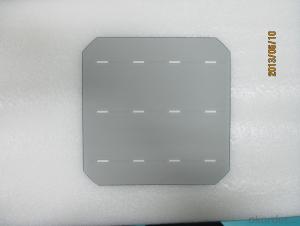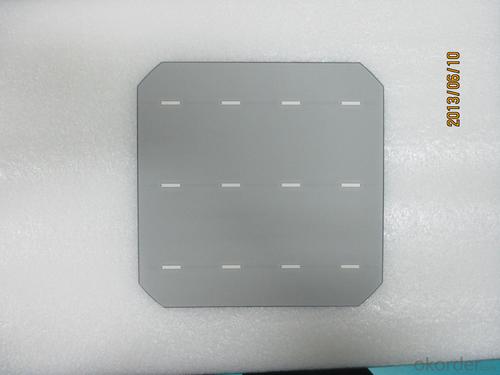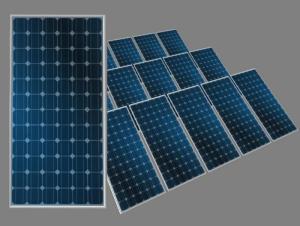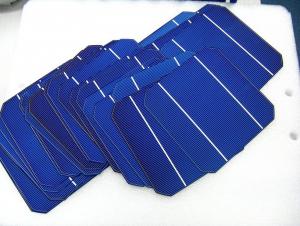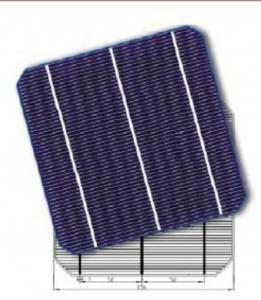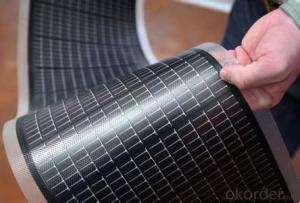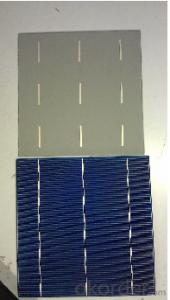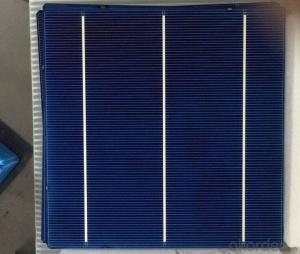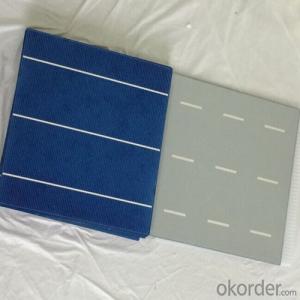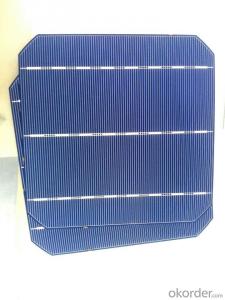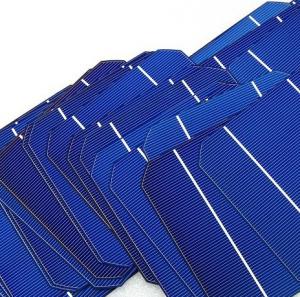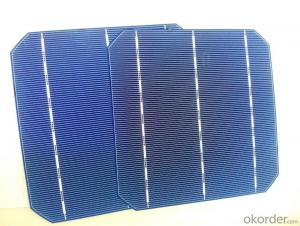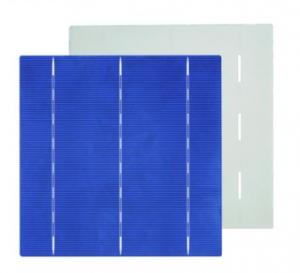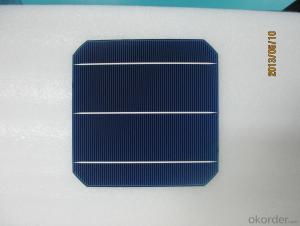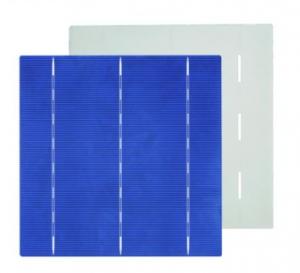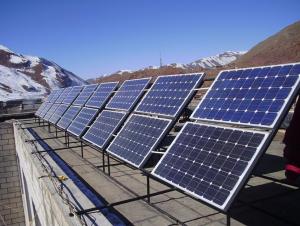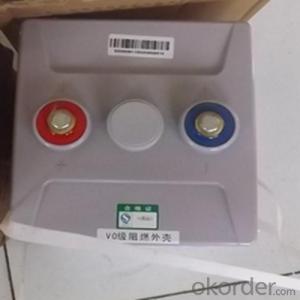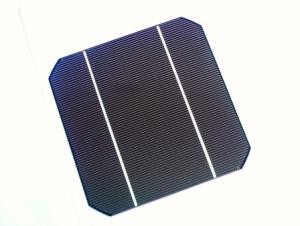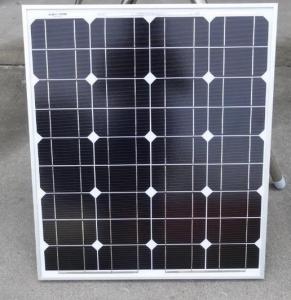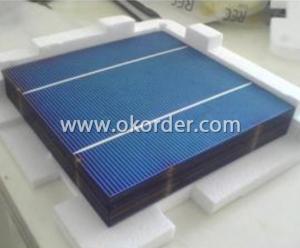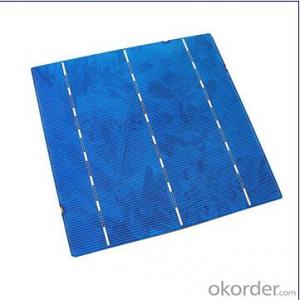Hot Solar Cells - Monocrystal Solar Energy Cell 156*156mm with 18.3% Efficiency
- Loading Port:
- China Main Port
- Payment Terms:
- TT or LC
- Min Order Qty:
- -
- Supply Capability:
- 1000000 PCS/month
OKorder Service Pledge
OKorder Financial Service
You Might Also Like
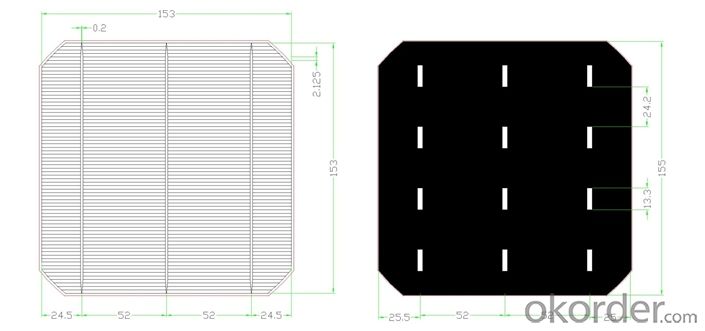
Monocrystal Solar Energy Cell
type:156M
appearance:156×1565㎜±0.5mm;diagonal:R=100mm
Main fence wide:1.4-1.5mm back electrode wide:2-2.5mm
Fence line qty:90
Cell thickness:220um±20um
Eff(%) | 18.00- 18.10 | 18.10- 18.20 | 18.20- 18.30 | 18.30- 18.40 | 18.40- 18.50 | 18.50- 18.60 | 18.60- 18.70 | 18.70- 18.80 | 18.80- 18.90 | 18.9- 19.0 | 19.1- 19.1 | 19.1- 19.2 |
Pm(W) | 4.30 | 4.33 | 4.35 | 4.37 | 4.40 | 4.42 | 4.44 | 4.47 | 4.49 | 4.52 | 4.54 | 4.56 |
Isc(A) | 8.71 | 8.73 | 8.76 | 8.77 | 8.78 | 8.82 | 8.83 | 8.85 | 8.86 | 8.88 | 8.9 | 8.93 |
Im(A) | 8.19 | 8.21 | 8.24 | 8.26 | 8.30 | 8.33 | 8.35 | 8.39 | 8.42 | 8.45 | 8.47 | 8.51 |
Voc(V) | 0.630 | 0.631 | 0.632 | 0.633 | 0.634 | 0.634 | 0.635 | 0.636 | 0.637 | 0.637 | 0.638 | 0.64 |
Vm(V) | 0.527 | 0.528 | 0.529 | 0.531 | 0.531 | 0.532 | 0.534 | 0.534 | 0.535 | 0.536 | 0.537 | 0.538 |
FF(%) | 78.6 | 78.7 | 78.8 | 79.0 | 79.2 | 79.3 | 79.5 | 79.6 | 79.8 | 80 | 80 | 80 |

remark:our company cells as per working current concentrate principle,separate the first and the second grade
Applications of Polycrystalline Solar Cells
Assemblies of photovoltaic cells are used to make solar modules which generate electrical power from sunlight, as distinguished from a "solar module" or "solar panel". A solar array generates solar power using solar energy.
Factory Picture of Solar Cells
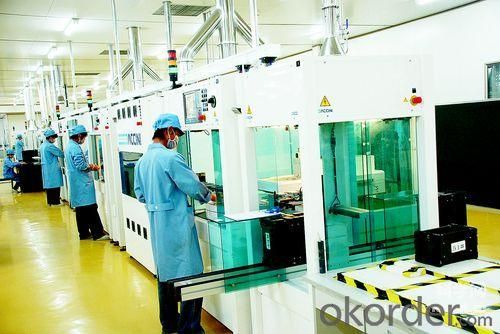
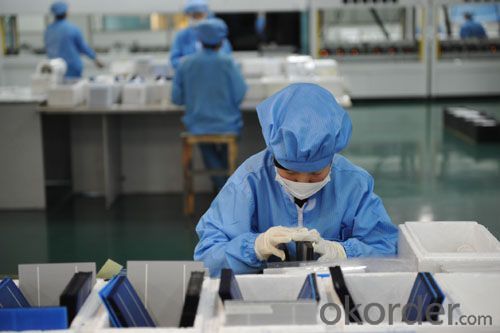
FAQ
We have organized several common questions for our clients,may help you sincerely:
What’s price per watt?
A: It’s depends on the quantity, delivery date and payment terms of the order. We can talk further about the detail price issue. Our products is high quality with lower price level.
Can you tell me the parameter of your solar cells?
We have different series of cells with different power output, both from c-si to a-si. Please take our specification sheet for your reference.
How do you pack your products?
We have rich experience on how to pack the panels to make sure the safety on shipment when it arrives at the destination.
Can you do OEM for us?
Yes, we can.
How long can we receive the product after purchase?
In the purchase of product within three working days, We will arrange the factory delivery as soon as possible. The perfect time of receiving is related to the state and position of customers. Commonly 7 to 10 working days can be served.
- Q: What is the role of solar cells in powering remote surveillance systems?
- Solar cells play a crucial role in powering remote surveillance systems by harnessing the sun's energy and converting it into electricity. This renewable energy source allows surveillance systems to operate in remote locations without relying on traditional power grids or expensive fuel sources. Solar cells provide a sustainable and reliable power supply, ensuring continuous operation of surveillance equipment, including cameras, sensors, and communication devices, even in areas without access to electricity.
- Q: Can solar cells be used in theme parks or amusement parks?
- Yes, solar cells can definitely be used in theme parks or amusement parks. They can be installed to generate clean and renewable energy to power various attractions, lighting, and facilities within the park. Solar cells are a sustainable and cost-effective solution that can help reduce the carbon footprint of theme parks and contribute towards a greener environment.
- Q: Can solar cells be used for indoor lighting?
- Yes, solar cells can be used for indoor lighting. However, they are generally less efficient indoors compared to outdoor environments due to the reduced amount of sunlight available. Additionally, indoor lighting usually requires a constant and reliable power source, which may be challenging to achieve solely through solar cells.
- Q: Can solar cells be used for powering schools?
- Yes, solar cells can be used to power schools. Solar energy is a renewable and sustainable source of power, and installing solar panels on school rooftops or grounds can generate electricity to meet the energy needs of schools. This can significantly reduce the reliance on fossil fuels and decrease carbon emissions, making it an environmentally friendly solution. Additionally, solar power can provide a reliable and consistent energy source, especially in sunny regions, ensuring schools have a stable power supply.
- Q: How do solar cells handle electromagnetic radiation?
- Solar cells are designed to efficiently convert electromagnetic radiation, particularly sunlight, into electricity. When electromagnetic radiation, such as sunlight, hits the solar cell, it excites the electrons within the cell's semiconductor material. This excitation creates an electric current, which can be harnessed as electrical energy. Therefore, solar cells are specifically designed to handle and utilize electromagnetic radiation to generate electricity.
- Q: What is the effect of dust or dirt on solar cell performance?
- The presence of dust or dirt on solar cells can significantly reduce their performance by blocking sunlight from reaching the cells, thereby reducing their efficiency in converting sunlight into electricity. The dust or dirt particles act as a barrier, preventing the photons from reaching the semiconductor material within the solar cells. This decreases the amount of electricity generated, resulting in a decrease in overall power output. Therefore, regular cleaning and maintenance of solar panels is essential to maximize their performance and ensure optimal energy production.
- Q: Can solar cells be used for powering communication towers?
- Yes, solar cells can be used for powering communication towers. Solar energy can be harnessed using photovoltaic cells, which convert sunlight into electricity. These cells can generate power throughout the day, making them a reliable source of energy for communication towers that require continuous operation. Additionally, solar cells can be integrated with batteries to store excess energy for use during nighttime or cloudy periods, ensuring uninterrupted power supply to communication towers.
- Q: How do solar cells perform in high-altitude locations?
- Solar cells perform well in high-altitude locations due to several factors. Firstly, at higher altitudes, there is often less air pollution and cloud cover, leading to more sunlight reaching the solar cells. Additionally, the thinner atmosphere at high altitudes allows for a higher concentration of solar radiation, resulting in increased energy generation. Finally, the cooler temperatures at higher altitudes can actually improve the efficiency of solar cells, as they tend to perform better in lower temperatures. Overall, solar cells are highly effective in high-altitude locations, making them an ideal renewable energy solution in such areas.
- Q: What is the maximum efficiency that a solar cell can achieve?
- The maximum efficiency that a solar cell can achieve is known as the Shockley-Queisser limit, which is approximately 33.7%. However, in practical applications, commercial solar cells typically have efficiencies ranging from 15% to 22%.
- Q: What is the role of bypass diodes in shading situations?
- The role of bypass diodes in shading situations is to minimize the impact of shading on the overall performance of a solar panel. When a section of a solar panel is shaded, it can significantly reduce the current produced by that section, leading to a decrease in the overall power output. Bypass diodes are connected in parallel to each solar cell or a group of cells within a solar panel to provide an alternative path for the current to flow when shading occurs. This allows the shaded cells to be bypassed, preventing them from affecting the performance of the unshaded cells. By utilizing bypass diodes, the solar panel can maintain a higher level of efficiency and generate more power, even in shading situations.
Send your message to us
Hot Solar Cells - Monocrystal Solar Energy Cell 156*156mm with 18.3% Efficiency
- Loading Port:
- China Main Port
- Payment Terms:
- TT or LC
- Min Order Qty:
- -
- Supply Capability:
- 1000000 PCS/month
OKorder Service Pledge
OKorder Financial Service
Similar products
Hot products
Hot Searches
Related keywords
